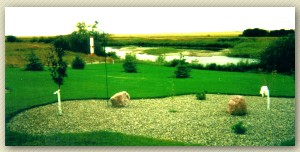

Maintaining Your Lawn!

How to Achieve a Healthy Lawn
Caring for your lawn is a balancing act. There are four things you need
to do - mow, feed, water, and weed. One influences the other. For example,
water and fertilizer make your lawn grow faster so you mow more often.
The key is striking just the right balance to minimize input while keeping
the lawn healthy.
Watering
Soil should be kept moist (not wet) with deep penetrating water applications to avoid wilting, density loss and to encourage deep root growth. If you water correctly, you can get by with watering less often. Apply 1 to 1 1/2 inches every 5 to 7 days during hot and dry periods of summer months. During spring and fall apply 1 inch of water per week in absence of rainfall. If you are unsure as to when to water, wait until you see signs of stress in your lawn before you water. If footprints remain in the sod, the blades are too limp to spring back. Also, a greyish cast to the lawn indicates that it is dry and needs water. Ideally, watering should be done as early as possible in the cool of the day (6 a.m. to 10 a.m.)
Mowing
Frequent mowing at the proper height keeps your lawn thick. A dense carpet of sod competes with invading weeds and withstands foot traffic. Meanwhile, a lawn that is allowed to grow tall during a vacation and then is cut back to its original height will be left thin and weakened. Weed seeds find their way to the surface of the soil and take hold.
For a high quality appearance keep the grass height at 1 1/2 to 2 1/2 inches. In summer months, or in shaded areas higher mowings preferred. Mow regularly with a reel or rotary mower allowing the clippings to remain. Irregular mowing practices may result in high buildups of thatch, which will require verticutting or mulching. Suggested not removing more than 1/3 of the growth during a single mowing.
Weed Control
The best way to control weeds is to have a healthy lawn that chokes them out before they get started. Don't mow your lawn too short, be sure to fertilize adequately, and water deeply. Beginning a good maintenance program will bring many weeds under control within one growing season without chemical intervention.
If you do apply a weed killer know what type of grass you have and the type of weed you want to kill. Always read and follow product labels carefully.
Fertilizing
Because you want to fertilize when the lawn is growing, cool-season lawns,
such as fescue, Kentucky bluegrass and cool-season blends will need to
be fed in early fall (September), late fall (November), and spring (late
February/early March). You may want to use one of the low-nitrogen, high-potassium
winterizing formulaes such as 8-8-25 for your late fall feeding and calculate
the rate as 1 pound potassium (instead of nitrogen) per 1,000 sq. feet.
The general rule for apply fertilizer is 1 pound of nitrogen per 1,000
sq. feet. However, this is just a starting point. If your lawn is growing
vigorously, gradually reduce the amount you apply.
When looking for a fertilizer you want to look for one that is at least 30% slow-release nitrogen. That means that the fertilizer granules will dissolve slowly and the nutrients will not wash away in the first hard rain.
Although believed to be accurate, any information on this website is not verified.
Please contact Chinook Sod Farms for confirmation.